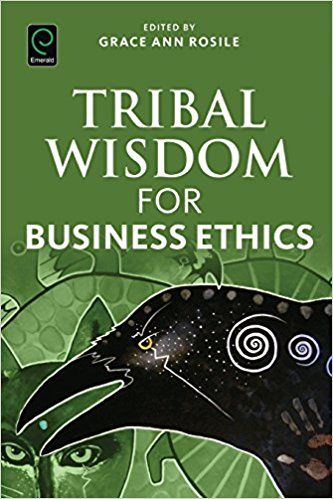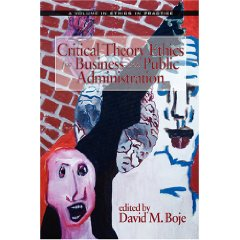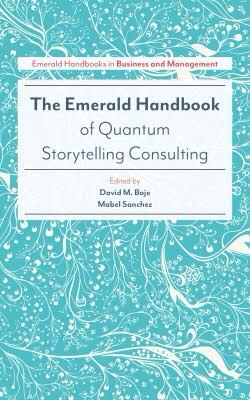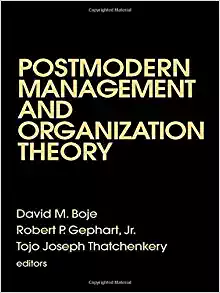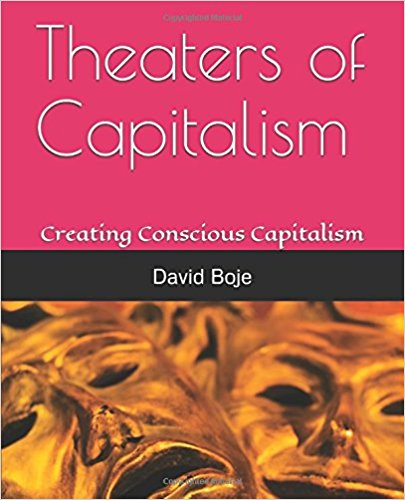April 27, 2019
Presentation to ISEOR Doctoral Students
SEE SLIDES:
Why is SEAM’s self-correcting ‘storytelling science’ better than Appreciative Inquiry at Conserving the Virtual Water of the Planet?
David M. Boje
Professor, Aalborg University (Denmark)
Emeritus Regents Professor, New Mexico State University
Director, European School of Governance
It is time to do
'storytelling science' that does refutation of
organizational theories rather than just
'appreciative inquiry' into ad hoc and
post hoc confirmations of what
corporations are telling us.Appreciative
Inquiry collects 'positive stories' and
affirms the grand corporate narratives of
positivity. Some water corporations are doing
bluewashing of the global water crisis that
they themselves are creating in order to make
more money. For example, it is ironic that
Goldman Sachs is ditching single-use plastic
water bottles (source)
while at the same time buying up fresh water
land with aquifers, lakes, water rights, water
utilities and shares in water engineering and
water technology companies. They are
making 'bets on the future (what I
call 'antenarratives) that by
controlling the supply of water
(& water engineering services)
that water demand will exceed
water supply, and the price of
fresh water will increase
astronomically. This
is no time to let Appreciative Inquiry be the
methodology of choice of multinational water
corporations unapologetically justifying the
privatizing and commodifying the world's fresh
water resources. I propose here a critical
'storytelling science' of self-correcting that
can help to avert a global water catastrophe.
People need to understand that 97.5% of the
planet's water is saltwater, leaving 2.5%
fresh water, and most of that is inaccessible
(too deep in the ground, or in glaciers and
snow packs). By 2050, if not sooner, some 4
billion people (most of the population of
planet earth) will be in severe water scarcity
(no fresh water to drink), while the rest of
humanity pays higher and higher prices for a
shrinking supply, that is hoarded in fewer and
fewer hands.
We need
to be preparing in advance to avert a fresh
water apocalypse. Today and everyday, 6,000
children die of preventable water-borne
illnesses, and entire cities are running short
of water, and some have no tap water, and no
water sanitation, and no toilets. People need
to become aware of where water comes from, who
owns it, and who is engaged in water
speculation markets, and manipulating
available water supply, to increase demand,
and affect water prices, so they can increase
their multibillionaire profits by even more
billions of dollars, and to what end? T. Boone
Pickens' new
company, Mesa Water, has been buying up
ground water
rights in
Roberts County, Texas - 200,000 acres in
all. He says that over a 30-year period, he
expects to make more than $1 billion on his
investment of $75 million (source).
Not just
Goldman Sachs understands the plastic
pollution pandemic of the planet, but also the
new 'water barons' of Wall Street banks (JP
Morgan Chase, Citigroup, UBS, Deutsche Bank,
Credit Suisse, Macquarie Bank, Barclays Bank,
the Blackstone Group, Allianz, and HSBC), plus
elitist multbillionaires such as T. Boone
Pickens, former President George H.W. Bush and
family (buying
water in Paraguay and the
Guarani
Aquifer System in Columbia),
Hong Kong's Li Ka-shing, Philippines' Manuel
V. Pangilinan, and other mutlibillionaires are
buying up as many acres of land with aquifers,
lakes, reservoirs, their water rights, and
water utilities, plus as many shares in water
engineering and water technologies as they can
get their greedy hands on, all around the
world (source).
For every narrative there is a
counternarrative. For example, the
counternarrative is the the Bush and family
aquifer in Columbia is being controlled by
multiple countries and Nestle, Coke, and
PepsiCo (source),
and the Bush family cannot possibly control
it: "
Following a
six-year study of
the aquifer — led by the World Bank —
Brazil, Paraguay, Uruguay and Argentina
agreed to a first-of-its-kind management
plan governing the use of an aquifer by
multiple countries that follows the
principles set out in the United Nation’s Law of
Transboundary Aquifers"(source).
Somehow I am not convinced the World Bank
has the well being of people and planet as
their number one priority (source).
" Representatives of [Nestle and Coca-Cola] have held meetings with government authorities to formulate procedures for exploitation by private companies of water sources, especially in the Guarani Aquifer, in concession contracts for over 100 years — [the senior official] added” (source).
We have
to ask these water barons to respond to Judith
Butler's (2005) request, 'Giving an Account of
Oneself.' This means asking each water baron,
Nestle, Coca-Cola, PepsiCo to give a moral
account of oneself, to serious be
self-reflexive about the hidden costs of life
on planet Earth from hoarding water for
speculation, taking water out of the public
domain, and placing it by privatization and
commodification, into the hands of water
speculators.
I am a
storytelling researcher. I study the
storytelling dynamics between corporate
narrative, counternarratives of activists, the
living stories of 'real people' who can only
live three days before dying of thirst, and
the antenarrative processes (the before,
beneath, between, becoming, and those risky
bets on the future of humankind and all living
species). Antenarratively, this means T. Boone
Pickens, G. H. W.. Bush, and other water
market speculators are making 'bets on our
future, not just their own greed) and are
taking water out of the hands of citizens to
do it, making water a trade commodity, a game
of water casino, gambling with the lives of
humanity and all species on planet
earth. Equally disturbing is the
collaboration of state and national
governments prohibiting citizens from becoming
self-sufficient by (1.) prohibiting rainwater
harvesting into ponds or rain barrels, (2.)
appropriating water rights of individual
citizens and separating water rights from land
ownership, (3) while granting multinational
water corporations (Nestle, Coca-Cola, &
PepsiCo) almost free well pumping rights, (4)
granting agriculture rights to withdraw as
much surface water from (lakes, rivers, and
reservoirs as they need, and (5) the increase
in plastic, chemical, and pharmaceutical
(medications) contamination and pollution of
fresh water globally. We know the secret
formula of both Coca-Cola and PepsiCo: its
caffeine, sugar, and salt so that your mouth
and stomach neurons are not connected to your
brain neurons that tell you this is a beverage
that 'makes you thirsty' and is anything but
'refreshing.' Big Sugar, Big Salt, and Big
Caffeine industry money pays lobbyists, buys
the complicity of politicians, to keep a
beverage in schools, colleges, restaurants,
and public buildings that actually is
unhealthy, resulting in obesity, diabetes,
heart failure, and so on. The plastic
industry profits, but its plastic leaches
toxicity, conveys in nanoplastic particles the
toxins, the solvents, the insecticides, and
every imaginable toxic particle into the food
chain, into the once fresh water, so there is
less and less really fresh water available for
life on planet earth. It is a time for
critical storytelling, to get at the whole
storytelling dynamics, in all its complexity,
and what my colleagues and I call 'True
Storytelling' and no more Fake Storytelling.
The
water speculation of elite multibillionaires,
Wall Street banks, and multinational water
corporations, is creating long-term, and
perhaps permanent destruction of the global
water cycle because it is a closed system, in
which, we have exactly as much total water, as
at the time of creation of planet Earth, but
the amount of fresh water (2.5%) that is
sanitary and drinkable, becomes marginally
less and lass due to its pollution, and its
privatization, speculative market
appropriation, and its commodification by
multinational water corporations (SeeBoje's Storytelling and Water Book)
Boje's (2019a)
Storytelling in the Global Age:THERE IS NO PLANET B
These trends ins water speculation markets,
water privatization of water utilities, and
water commodification of public water into
business water products is creating and
exacerbating a downward spiral of longer and
longer-term global water crises resulting not
only in the destruction of marine and land
species, but in the death of most of human
kind, by the end of this century.
Let Dwi
mean the effective Demand for Water
for Period i, expressed unity of multinational
water corporation's income for the period (1-I) to
the Swi
supply of water.
Ew0/Sw0 x Dw1/Sw1 x .
. . x Dwi/Swi
x Dwn/Swn
The Dw
exceeds Sw in year 2030 by 40%.
At the same time and globally, the multinational
water corporations as they privatize and commodify
water will dramatically increase the price (P) to consumers of water
utility services, and increase as well prices of
bottled water, bottled juice, bottled energy drinks,
and bottled soda. This will in turn create a long
term cycle of water speculation as multi-billionaire
investors buy up water rights around the world,
thereby further escalating the price (P) to
consumers of fresh water utility bills and bottled
sorts of water, soda, juice, and energy drinks.
"Thus, global demand for water in 2030 could prove
close to double what it was in 2005— exceeding
existing capacity by 40 percent" (McKinsey
Report, p. 77).
Socio-Economic
Approach to Management (SEAM) can help the
global water crisis by doing 'hidden cost'
calculations of the 'true' cost of virtual water,
and by doing scientific methods of intervention and
experimental projects that change multinational
corporation water behaviors in their total supply
and distribution chains. Virtual Water is defined as
the total water it takes in the supply chain to
produce a given product or service. When people
drink a bottle of Coca-Cola, or Nestle brand of
Bottled Water or a PepsiCo Energy Drink, they can
stop and think about just how much TOTAL WATER (or
virtual water it takes in the entire supply and
distribution chain, including the energy, the oil
and gas it takes for machinery, offices, vehicles,
and so on.
"The water footprint of an
individual, community or business is defined as
the total volume of freshwater that is used to
produce the goods and services consumed by that
individual or community or produced by the
business" (source).
These are the
Predictions:
By 2030 global
water demand will be 40% greater than it is today (McKinsey
Report).
By 2030 40% of world’s population will lack access to safe, sanitary water.
In 2030 there will need 60% more fresh water to support demand than we have today in the water cycle.
Developing nations are increasing water withdrawals by 50% and 18% in developing nations.
In short, the
fresh water system, if it were a bank, has more
withdrawals than deposits, and is bankrupt!
Virtual water by every corporation is now answerable
in a socially responsible capitalism.
How is the SEAM method related to Karl Popper and to Charles Sanders Peirce?
Virtual
Water is Not Understood by the General
Public. Every product and service requires 'virtual
water.'
Virtual water
trade refers to the hidden flow of water if food or
other commodities are traded from one place to
another. For instance, it takes 1,340 cubic meters of water to
produce one metric tonne of wheat.
SEAM can help
every organization on Earth to develop Hidden Cost
accounting of Virtual Water in their supply and
distribution chain. How does water capitalism become
socially responsible using SEAM's self-correcting
storytelling methodology?
See Boje
& Rosile's Book: 'Doing storytelling
science'
A
'storytelling science' uses self-correcting
abduction-induction-deduction to get at closer
approximations to 'True Storytelling' of the hidden
costs of water, and the Whole Storytelling of the
Water Situation Globally.
SEAM is a scientific method that
converts the downward spiral of Virtual Water's
Hidden Cost into the Upward Spiral Momentum of
Socially Responsible Capitalism. SEAM has a
scientific methodology for socio-economic
interventions into the behavior of multinational
corporations.


With SEAM's Hidden Cost Diagnostic, and
DPIE's done to conserve Virtual Water, a self-correcting
storytelling science methodology becomes possible.

Problems of France and the World that SEAM
'storytelling science' can address:
SEAM is already about storytelling science:

ARCHIVE:
2018 Presentation to ODC Conference in
Lyon, France

- VIDEOS several short excerpts and the
17 minute entire Youtube:

-
What's #1 Extinction threat that can bring about end of Humanity? According to David Boje's world tour focus group's, audiences are saying its Donald J. Trump.
-
Grounded Theory has no theory and no research. Action Research has no action and no research. David Boje takes on the two icons and presents a 4th wave approach.

-
David Boje presents contributions of Henri Savall's socioeconomic approach to change management at the international ODC meeting. Contributions include double spiral, scientific approach to researcher-intervention 'storytelling' that is beyond limits of action research, in an ontological approach of 4th wave grounded theory, and socially responsible capitalism before 6th extinction is irreversible.

-
SLIDES for 2018 ODC Conference: Contributions of Savall's Socioeconomic Double Spiral and Multiplicity to Change Management
-
At Iseor Tuesday and Wednesday (June 5th & 6th 2018 ) from 9 am to 5.30 pm class “Publishing technics” with Professors David Boje, Grace Ann Rosile and Robert Gephart
At this year's ODC International Meeting my paper and slides make these points:
- Grounded Theory has ‘no ground’ and ‘no theory’! (Boje, 2018a, in press)
- Action Research has ‘no action’ and ‘no
research’! (Boje, 2018b, in press);
see 2016 paper ("SEAM’s ‘Storytelling Dialectical
Method’ and the
Failure of Appreciative Inquiry as a Scientific Method of Organizational Development and Change") and slides from 2016 Boje presentation to Organizational Development and Change (international Academy of Management Conference, Lyon).
- ODC and SEAM are the minority compared to the 10 Giants of Consultancy $65.5 billion industry! (Boje & Sanchez, 2018a, in press)
- Parker (2018) is right! It is time to ‘bulldoze’ 13,000 business schools to make room for IAELyon PRME and True Storytelling (http://truestorytelling.org), Enough Fake (Boje, 2018a, in press).
The solution to these four problems is to be found in Savall's Contributions to scientific consulting and to a new business school model.
ABSTRACT Savall and colleagues contribute a management science of intervenor-research experimentation that goes beyond the inductive fallacy of ‘no ground’ and ‘no theory’ in Grounded Theory (GT) and the ‘no action’ and ‘no research’ in Action Research (AR). Savall’s 1975/2010 double spiral and Savall and Zardet’s trilectic, hidden cost, and qualimetrics approaches are explained in this presentation. Their contribution can become a new methodology and praxis of Organization Development and Change (ODC) that needs to be embraced by the 10 consultancy firm giants that make both SEAM and ODC in Academy of Management (AOM) the little David’s facing Goliath. A viable alternative is the IAELyon PRME business school model that implements the 17 UN sustainability goals.
Keywords: Dialectic, Savall, Spiral, Change Management, Action Research, Grounded Theory, ODC
If ODC is to change the world, it must overtake the dominant form of consulting by the 10 consultancy giants, that are totally infected with and disseminating the TFW virus throughout US Fortune 500.

Table above from Boje 2018 presentation on Savall contributions
Abbreviated Chronological Reading List on Savall Contributions:
Savall, Henri. (1975/2010). Work and People: An Economic Evaluation of Job-Enrichment. 1975 book "Enrichir le trail human dans les enterprises et les organizations". 2010 English version is Translated from French by M. A. Woodhall. Charlotte, NC: Information Age Publishing, Inc.
Savall, H. (1983). Germán Bernácer. La heterodoxia
en la economía (No. halshs-00783092).
Savall, H. (2003). An updated presentation of the
socio-economic management model. Journal of
Organizational Change Management, 16(1), 33-48.
Savall, H. (2001). interview with the SEAM Faculty (Henri
Savall, Veronique Zardet, Marc Bonnet and Michel Péron),
conducted by Grace Ann Rosile and David M. Boje,
taped and transcribed, from, 2.
Savall, H. (Ed.). (2004). Crossing frontiers in
quantitative and qualitative research methods: first
international co-sponsored conference, Research Methods
Division, Academy of Management (USA); March 18-20, 2004,
Lyon, France. 1 (2004). ISEOR.
Savall, H., & Zardet, V.
(2005). Tétranormalisation: défis et
dynamiques (No. halshs-00783085).
Savall, H., & Zardet, V. (Eds.). (2013). The
dynamics and challenges of tetranormalization. IAP.
Péron, M., & Savall, H. (2007). Raising the Curtain on
Business Operation Theatrics. Revue Sciences de
Gestion, (58).
Savall, H., & Zardet, V. (Eds.).
(2008). Mastering hidden costs and socioeconomic
performance. IAP.
Savall, H., Zardet, V., & Bonnet, M.
(2008). Releasing the untapped potential of
enterprises through socio-economic management (No.
halshs-00780720).
Savall, H., Zardet, V., Bonnet, M., & Péron, M.
(2010). contribution of qualimetrics
intervention-research methodology to transorganizational
development (No. halshs-00749946).
Savall, H., & Zardet, V. (Eds.). (2011). The
qualimetrics approach: Observing the complex object. IAP.
Savall, H., Zardet, V., & Péron, M. (2011). 22 The
Evolutive and Interactive Actor Polygon in the Theater of
Organizations. Storytelling and the future of
organizations: An antenarrative handbook, 366.
Savall, H., Zardet, V., Péron, M., & Bonnet, M.
(2012). Possible Contributions of Qualimetrics
Intervention-Research Methodology to Action
Research. International Journal of Action
Research, 8(1), 102-130.
Worley, C. G., Zardet, V., Bonnet, M., & Savall, A.
(2015). Becoming agile: How the SEAM approach to
management builds adaptability. John Wiley & Sons.
Savall, H., Péron, M., & Zardet, V. (2015, September).
Human Potential at the Core of Socio-Economic Theory
(SEAM). In Decoding the Socio? Economic Approach to
Management: Results of the Second SEAM Conference in the
United States(p. 1). IAP.
Savall, H., & Zardet, V. (2015). Reflecting on SEAM in
the 21st Century. The SocioEconomic Approach to
Management Revisited: The Evolving Nature of SEAM in the
21st Century, 1.
Savall, H. (2016). TFW virus concept history.
In Decoding the socio-economic approach to
management: Results of the second SEAM conference in the
United States.
Savall, H., Péron, M., Zardet, V., & Bonnet, M.
(2018). Socioeconomic Approach to
Management. Socially Responsible Capitalism and
Management, 73 (90), 18.
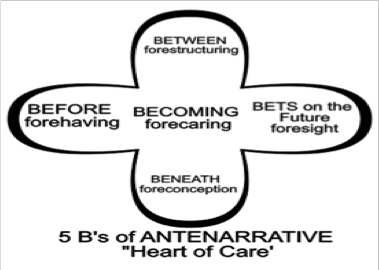
Since Boje (2001) Antenarrative has evolved from 2 B's (before-narrative & bets on the future) to 5 B's.

Antenarrative-storytelling not only allows
us to make sense of the past, it perhaps more importantly
allows us to draw conclusions about how current actions
may create future outcomes. This future-orientation is
especially relevant for ethical choices.
Margarita Glass Globalization is rooted in a Naive Ethics of Monopoly Capitalism. We need a Dialogical Answerability ethics because the Naive Instrumental and the Kantian Categorical ethics are leading to 6th Extinction. Virtue Ethics using a True Storytelling Praxis is a way to proceed to a middle path.

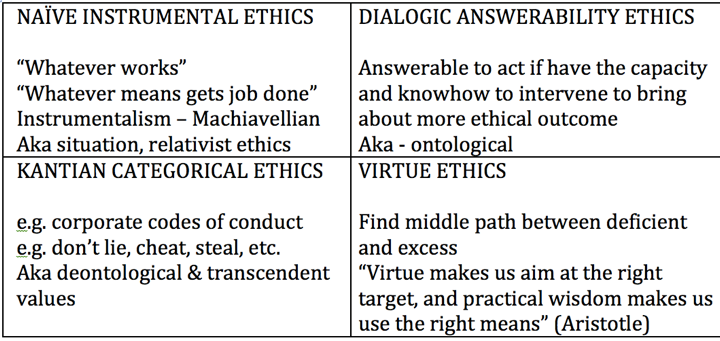
It is possible to rein in 6th Extinction form of Globalization with implementation of the 17 UN Sustainability Goals. Here is a True Storytelling Method of implementation

What are the True Storytelling Principles?
- Truth: You yourself must be true and prepare the energy and effort for a sustainable future
- Make room: True storytelling makes spaces respecting the stories already there
- Plot: You must create stories with a clear plot creating direction and help people prioritize
- Timing: You must have timing
- Help stories along: You must be able to help stories on their way and be open to experiment
- Staging: You must consider staging including scenography and artifacts
- Reflection: You must reflect on the stories and how they create value

Related Presentations
-
True Storytelling Workshop Slides DJØF May 16 2018 It has 7 ethical storytelling qualities and 7 principles of True Storytelling. Works through examples of how to develop 17 UN sustainability goals in local communities, schools, universities, cities, and municipalities using True Storytelling Praxis approach
True Storytelling is ethical praxis, a methodology, & antenarrative process of strategy. It is opposite of fake news, fake story, or fake CSR. In the Copenhagen True Storytelling Seminar Youtube, David Boje, Jens Larsen, and Danish National Police Commissioner Jens Henrik Højbjerg explore the method and practice of true storytelling. They develop examples for police, business, united nations sustainability goals, education, and health care. Slides and info at http://truestorytelling.org
More on Antenarrative Methods (slides form Helsinki)
-
Living Story alternatives to Western Narrative Globalization and Human Extinction (slides from Helsinki 25 May 2018).
-
YOUTUBE: Antenarrative critique Apple and VW Fake CSR Storytelling Hastening 6th Extinction May 25 2018 Helsinki Finland
David Boje uses antenarrative methods to critique Apple's & VW's Fake narratives of CSR, along with Neoliberalism, and Economist narratives of globalization. Living story (indigenous ways of knowing) ways of existing hold answers to saving humanity from 6th Extinction. Held at Aalto University, Helsinki Finland May 25 2018.
Antenarrative Reading List
Boje, D. M. (2001). Narrative methods for organizational & communication research. Sage.
Boje, D. M. (2008). Storytelling organizations. Sage.
Boje, D. M. (Ed.). (2011). Storytelling and the future of organizations: An antenarrative handbook. Routledge.
Vaara, E., & Tienari, J. (2011). On the narrative construction of multinational corporations: An antenarrative analysis of legitimation and resistance in a cross-border merger. Organization Science, 22(2), 370-390.
Weick, Karl E. "Organized sensemaking: A commentary on processes of interpretive work." Human Relations 65.1 (2012): 141-153.
Rosile, G. A., Boje, D. M., Carlon, D. M., Downs, A., & Saylors, R. (2013). Storytelling diamond: An antenarrative integration of the six facets of storytelling in organization research design. Organizational Research Methods, 16(4), 557-580.
Haley, Usha CV, and David M. Boje. (2014) "Storytelling the internationalization of the multinational enterprise." Journal of International Business Studies 45, no. 9 : 1115-1132.
Boje, D. M., Haley, U. C., & Saylors, R. (2016). Antenarratives of organizational change: The microstoria of Burger King’s storytelling in space, time and strategic context. human relations, 69(2), 391-418.
Boje, D. M., Svane, M., & Gergerich, E. M. (2016). Counternarrative and antenarrative inquiry in two cross-cultural contexts. European Journal of Cross-Cultural Competence and Management, 4(1), 55-84.
Vaara, E., Sonenshein, S., & Boje, D. (2016). Narratives as sources of stability and change in organizations: Approaches and directions for future research. The Academy of Management Annals, 10(1), 495-560.
Stierand, M., Boje, D. M., Glăveanu, V., Dörfler, V., Haley, U. C., & Feuls, M. (2017). Paradoxes of “creativity”: Examining the creative process through an antenarrative lens. The Journal of Creative Behavior.
Riach, K., Rumens, N., & Tyler, M. (2016). Towards a Butlerian methodology: Undoing organizational performativity through anti-narrative research. human relations, 69(11), 2069-2089.
“Butler-inspired notion of ‘anti-narrative’ interviewing, to which we now turn, in order to develop, in a very practical sense, a method of data generation and analysis that would reflect our methodological commitment to a reflexive undoing of organizational performativity”
“Our anti-narrative approach therefore seeks to disrupt the apparent linearity, stability and coherence of organizational performances by ‘undoing’ (Butler, 2004) seemingly coherent subjectivities as a methodologically reflexive move.”
What can we do to make it work? Mother Earth Economy Model is True Storytelling of our Potentiality
IWOK stands for Indigenous Ways of Knowing. Mātauranga Māori means Māori Ways of Knowing (MWOK) the environment. Both are about Webworks of Living Stories that are different from Western narrative research methods that reduce the aliveness of living story to form and linear plot structure. Boje will introduce deep layers of living story research using the Volkswagen Dieselgate scandal and its relation to conflict mineral mining after generations of colonization in Democratic Republic of Congo.
I am increasingly concerned about the current state of Globalization Storytelling in what Zygmunt Bauman calls 'Liquid Modernity.' It is a time when Post-Fordism has merged with the worst of Postmodern hyperreality, in a time of Fake News, Fake Presidents, Fake Corporations where getting to 'true storytelling' methodology is all but impossible. We live in a time when racist rhetoric, ethnic prejudice, and climate denial has become normalized in Western ways of narrative in our academic and political institutions. I think its time to engage in more IWOK and less WWOK of corporate speak, a more critical postmodern paradigm of storytelling.
Kaua e takahia te mana o te tangata Nga Huia Te Awe Kotuku – Don’t trample on the integrity of the people -- cited in Tuhiwai Smith 1999: 120





